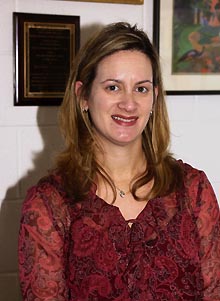|
This is an archived article.
For the latest news, go to the Advance
Homepage
For more archives, go to the Advance Archive/Search Page. |
||
|
Gort Wins Federal Grant To Help
Teachers Serve Bilingual Learners By Janice Palmer
Mileidis Gort, an assistant professor in the Department of Curriculum and Instruction, will lead a team of education faculty who will spend the next five years training teachers to better understand and serve the needs of some 69,000 students in the state who speak a language other than English at home. Eliana Rojas, an assistant professor of bilingual education, is serving as project director.
Growing Need
"The lack of teachers qualified to work with English language learners is demonstrated by the gap in academic performance between native and non-native English speakers," Gort says. The 2001 Connecticut Mastery Test results demonstrate her point. Just 15 percent of non-native English speaking students met the reading requirement, compared to 70 percent of native English speakers. Gort, who immigrated to the United States from Cuba when she was eight years old, believes bilingualism in the U.S. is "handled backwards", particularly in light of studies indicating its benefits in cognitive flexibility, metalinguistic awareness - the ability to reflect upon and manipulate language, and recognition of the value of diversity. "Bilingual children come to school with linguistic riches that we take away from them through the subtractive nature of English-only educational programs," says Gort. "Then, when they reach the secondary level, we require students to learn another language. Yet they are graduating from high school with no significant level of bilingualism." The federal grant will address two of the state's specific needs: certification and training of bilingual and mainstream teachers. Teacher Training
A second concentration area in the master's degree bilingual program, "Teaching English to Speakers of Other Languages," will be created in response to a new state law requiring the mainstreaming of bilingual students within 30 months. Gort points out that a potential difficulty of such a mandate is that students learn at different rates, so not all bilingual students will be ready within that time period. "This means mainstream teachers will have bilingual learners in their classroom who may not be ready to do academic work in English with no native language support," she says, "and many of these teachers may not realize that a child does not stop being bilingual just because he or she has been mainstreamed." This is where in-service teacher training comes in. A consortium of six school districts is being established to create an ongoing collaboration of information and support among schools in Hartford, East Hartford, Meriden, New London, Norwich, and Windham. Gort's team will provide needs-based professional development for these districts, which will include several assessments for determining what training is needed. Workshops, colloquia, and conferences will be designed to answer those needs. Knowledge Base
Gort sees this project as an opportunity to help educators and communities overcome some of the misconceptions about bilingual education and bilingual learners in general. Two of the most damaging ones she says, are the belief that bilingual education programs teach children only in their native language, when in reality they are learning English from day one; and that many people think such programs are only for the Spanish-speaking community. Gort, who is about to become a mother for the first time, looks forward to raising her child bilingually. She will speak Spanish to her daughter, while her husband speaks English. |
 new $1.3 million federal
grant, funded through the No Child Left Behind Act, will help the
Neag School of Education better prepare Connecticut's teachers
for the growing number of bilingual students in their
classrooms.
new $1.3 million federal
grant, funded through the No Child Left Behind Act, will help the
Neag School of Education better prepare Connecticut's teachers
for the growing number of bilingual students in their
classrooms.
